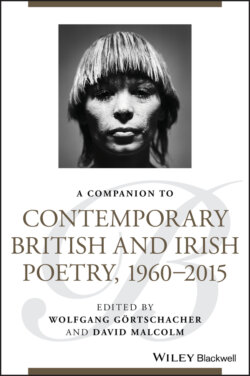Читать книгу A Companion to Contemporary British and Irish Poetry, 1960 - 2015 - Группа авторов - Страница 32
Carol Ann Duffy, “Adultery” (1993) (Duffy 2004, 116–117)
ОглавлениеThe title is unassuaged, unsoftened. It is impossible to break up the 11 stanzas into smaller thematic units. The poem is an emotional cascade uttered by a (probably) female speaker. Is it addressed to anyone? A “you” is mentioned throughout the poem, but it is better to recognize this as a piece of self‐address, rather than as address to another.
The poem seems utterly disordered. There is no rhyme. Line length is extremely variable—from 5 to 15 syllables. Numbers of main stresses per line are also variable—between three and five in most cases, although line 2 has two or three, and line 32 has seven. Indeed, it is difficult to see any regular pattern of stresses and feet in the whole poem. Single‐stress feet and four‐ or even five‐syllable feet occur frequently. For example, line 33—“in a marital bed, the tarnished spoon of your body”—appears to be patterned, thus: xx/xx/|x/x/|xx/x. This is a typical line scansion in the poem. Main stresses cluster—for example, in lines 4 and 5, in line 12, and in line 20. There is much enjambment—lines 2, 3, 6, 7, 15, 16, 25, 26, 29, 30, 41, 42, 43, and 44, and the radical interstanzaic enjambments of lines 8, 9, 12, 13, 20, and 21.
The abrasive and disjointed quality of the above is augmented by aspects of the language. Imperatives organize the text: “Wear” (line 1), “Suck” (line 13), “Do it do it do it” (line 17), “So write” (line 37). Fragments are rife: for example, “A sick, green tint” (line 4), “Sweet darkness / in the afternoon” (ll. 17–18), “Then, selfish autobiographical sleep…” (ll. 32–34), “And all / for the same thing twice” (ll. 41–42). Syntax breaks down: “up against a wall, faster” (l. 15). Punctuation goes by the board at times: “Do it do it do it” (l. 17). Questions do not have question marks—lines 28 and 43. Repetitions give a raw intensity to the text: “Do it do it do it” (l. 17), “all for the same thing twice. And all / for the same thing twice” (ll. 41–42), and “Fuck. Fuck” (l. 43).
Part of the text's disturbing quality lies in its conjunction of the literal and the figurative—simile/metaphor/metonymy. Indeed, this juxtaposition structures the poem. For example, in stanza 1, “dark glasses” (literal) join with looking “as though through a bruise” (simile). The gloves and hands of stanza 2 (literal) meet with the speaker's sense of being “naked under your clothes all day / slim with deceit” (metaphor) in stanza 3. The “telltale clock” (metonymy) morphs into the adulteress's excited face on a bed sheet (literal) in stanzas 5 and 6. And so on. This intense and powerful poem pushes constantly at the containing forces of verse, of language constraints, and of consistency (literal or nonliteral) to produce something very like a dramatic monolog of a speaker who is shaken and disturbed by the joys and terrors of her actions.
